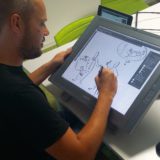Visual storytelling for ‘testing the future’
In strategic projects, we try to make a bridge from now to a desirable future. The bridge tends to consist of ideas and concepts on how to get to that future. Often we call this a roadmap. Obviously, in a commercial context, it is key to involve customers in the making of a roadmap. Especially in business-to-business, you would like them to continue to be your customers in the future.
Customer conversations can be carried out to explore their emerging needs and the future challenges they foresee. This will give you insight into your potential future business with them. Through a creative process you can then generate ideas for solutions, which could be products or services or partnerships, or other new ways of providing value. Ideas can be put on a timeline according to capabilities and knowledge required. And voila, a roadmap is born.
 But, do not forget to test and validate your ideas with your customers. Some solution-ideas may be nonsense or missing the point, and your customers will see this more clearly than you will, since they would be the ones spending the money. So go back to (some of) your customers with your ideas to ‘test the future’: where is the real potential, what triggers enthusiasm, where are the critical barriers for adoption?
But, do not forget to test and validate your ideas with your customers. Some solution-ideas may be nonsense or missing the point, and your customers will see this more clearly than you will, since they would be the ones spending the money. So go back to (some of) your customers with your ideas to ‘test the future’: where is the real potential, what triggers enthusiasm, where are the critical barriers for adoption?
For both types of customer conversation, those on emerging needs and those to test ideas, it is key to bring trigger material that will spark the conversation. Ideally this material includes visuals and provides inspiration for your customers. For example you can make trends cards or posters with future developments and images of early examples.
examples.
For testing new ideas early on, it is key to have short idea descriptions, visualised in a way that shows the principle of how it fulfils a need, without getting into too much detail on the exact execution. Visual storytelling is required instead of showing product ideas. This way you can have a strategic conversation with customers about what will help them to meet their needs, rather than get feedback on what is good or bad of a specific idea, shape or design.
The photos show a current project, working on a strategic roadmap for and with a client. It was a delight to come up with ideas with the team of the client and develop them into stories with Marlies Bielderman, who carried out the first round of customer conversations. Drawing-miracle-maker Jan-Jaap Rietjens of Splinter makes the drawings to bring the stories alive. He works fast and efficient, a sking the right questions and thinking along with a no-nonsense mindset. Drawing helps to bring ideas down to earth. E.g when you cannot describe an example situation to draw, in which an idea would be of benefit, this can be an indication that the idea may be just too ‘fluffy’ or far-fetched. Now, with the storylines under development, we are already looking forward to the next round of customer conversations, to talk about the ideas and engage them in developing a roadmap towards a desirable future.
sking the right questions and thinking along with a no-nonsense mindset. Drawing helps to bring ideas down to earth. E.g when you cannot describe an example situation to draw, in which an idea would be of benefit, this can be an indication that the idea may be just too ‘fluffy’ or far-fetched. Now, with the storylines under development, we are already looking forward to the next round of customer conversations, to talk about the ideas and engage them in developing a roadmap towards a desirable future.

